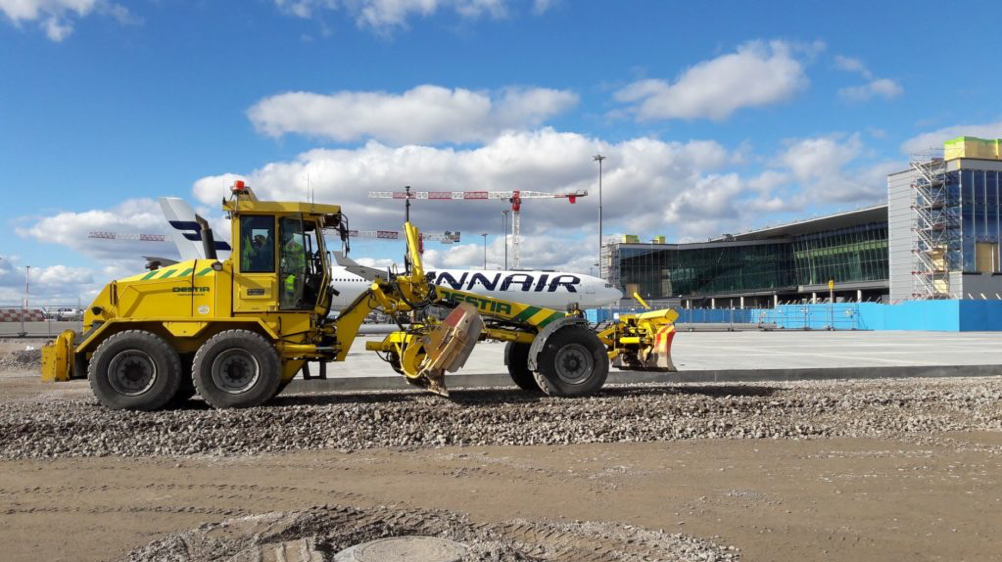Helsinki Airport Expansion with Infrakit
”Before Infrakit, system information management was difficult – we were practically expecting an error to occur when transferring data with a USB drive one machine at a time.”
Tero Maijala, Land Surveying Specialist, Destia Oy
Increasing transit capacity on Helsinki Airport is one of the main objectives of the airport’s 2020 development program, which aims to secure the airport’s competitiveness as one of the most cost-efficient transit hubs with the highest quality service standards in Northern Europe. Helsinki Airport broke the barrier of 20 million passengers for the first time in 2018.
By 2020 the terminals will be expanded with 103 000 square meters, increasing the total area of the airport to more than 250 000 square meters. There will be an increase of 50% in baggage handling capacity and the number of bridge gates for wide-body aircraft will be doubled from 8 to 16.
Extension of the airport apron is a central part of the strategy. The infrastructure was constructed by Finnish Destia on an area totaling approximately 45 hectares, including construction of 15 aircraft parking spaces on a concrete slab. The work is still ongoing with three more aircraft parking spaces being renovated.
Usage of Infrakit in the project
“Destia was an early adopter of Infrakit, and we typically use it for information management, quality assurance and volume tracking of the site. Therefore it was a given that Infrakit would be a part of the construction process at the airport, as well.
In this project we used Infrakit as a tool for sharing as-planned models, as-built measurements and on-site photos between the office and the site, i.e. as a model-based infra production tool, not so much as a project bank”, Destia’s Land Surveying Specialist Tero Maijala describes using Infrakit at the airport construction site.
Benefits to the project
”The benefit of using Infrakit is comprehensive information management between the office and the site. The as-planned models for machine control are made at the office and then uploaded to automation machines via Infrakit server. The information is transferred to all machines in the project in just 5 minutes – this way everyone has the latest material at their disposal. Different parties involved in the project, like surveyors, planners and managers, also have access to the up-to-date as-planned models.”
”As-built measurements from work machines transfer to Infrakit almost in real time, allowing both the client and the management to monitor the quality of construction directly from the office. Infrakit organizes the files into correct folders according to building elements, making downloading files easy.”
”Site supervisors working mainly in the field use the Infrakit mobile app, where they can overlay the plans on different project maps. They also take photos of the site with the app, making it easy to analyze items in the office”, Maijala explains.”
Difference to the past
“If we didn’t use Infrakit at the site, our information management would be split up between task-specific equipment and systems, causing considerable issues as each equipment provider have their dedicated software platforms. The contractor would have to use multiple overlapping systems for production management and the same issues would apply to quality assurance of the client. Updating information would be difficult and the risk for the updates being out-of-date would increase significantly. Information would become fragmented and update management would be challenging.”
”Before Infrakit, system information management was difficult – we were practically expecting an error to occur when transferring data with a USB drive one machine at a time. One of the main challenges was confirming that we had gone through every single machine, since some of them might not have been in use or a machine’s location on site might have been changed. Infrakit was the first to offer the idea and a platform where systems from different manufacturers could be integrated, making transferring data possible regardless of the brand of the device.”
Using Infrakit in the future – would you recommend Infract for similar projects?
”Absolutely. Site information management is key to a successfully executed project. Infrakit offers a brilliant tool for this, enabling transferring up-to-date plans and implementation materials to all the automation machines in the project simultaneously. Information management of the work machines is taken care of in the office while you decide what’s on the machines”, Maijala recommends.

Published 10.7.2019

